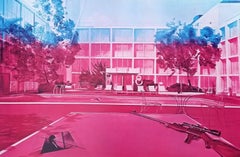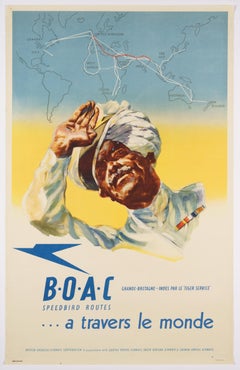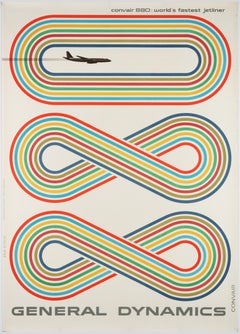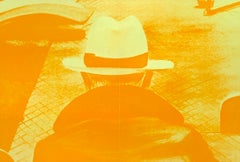Jacques Monory Figurative Prints
French, b. 1934
French artist Jacques Monory, one of the leaders of the narrative figuration movement. Having trained at the École des Arts Appliqués in Paris, Jacques Monory quickly developed a passion for photography, which he integrated into his art, namely with his famous monochrome blue backgrounds.to
1
1
1
Overall Width
to
Overall Height
to
1
1
17
884
384
370
310
3
2
1
2
1
2
1
1
1
1
1
1
1
1
1
1
1
1
1
1
1
3
Artist: Jacques Monory
Jacques Monory - In Honor of Oklahoma's War Heroes, Original Screenprint SIGNED
By Jacques Monory
Located in Paris, IDF
Jacques Monory
In Honor of Oklahama's War Heroes, 1976
Original screen print
Handsigned
On BFK Rives 38 x 28 cm (c. 14x 11 in)
Limited to 300 exemplary, not numbered
INFORMATION: ...
Category
1970s American Modern Jacques Monory Figurative Prints
Materials
Screen
Spectacular : Surprised Girl - Original vintage lithograph poster, Maeght 1976
By Jacques Monory
Located in Paris, IDF
Jacques Monory
Spectacular : Surprised Girl, 1976
Original vintage lithograph poster
Created for Monory's exhibition at Maeght Gallery
On paper 60 x 45 cm (c. 24 x 18 in)
Excelle...
Category
1970s Pop Art Jacques Monory Figurative Prints
Materials
Lithograph
Hotel Fusil
By Jacques Monory
Located in Saint Ouen, FR
Beautiful offset lithography by Jacques Monory.
Numbered and signed by the artist in pencil.
Issue 31/79
Size of the work 52 x 80 cm
Size with white margin: 73 x 100 cm
Perfect cond...
Category
1980s Jacques Monory Figurative Prints
Materials
Paper
Related Items
BOAC Speedbird Routes Across the World – Original Vintage British Airline Poster
By Harold Foster
Located in Zurich, CH
Original Vintage Airline Poster by Harold Foster. He created several designs commissioned by the British Overseas Airways Corporation ...
Category
Mid-20th Century Jacques Monory Figurative Prints
Materials
Paper
$2,300
H 39.97 in W 25.01 in D 0.04 in
General Dynamics, Convair 880, World's Fastest Jetliner – Original Poster
By Erik Nitsche
Located in Zurich, CH
A poster belonging to Erik Nitsche's third series for General Dynamics, promoting its Convair Company.
Founded 1952, General Dynamics hired Nitsche a...
Category
Mid-20th Century Modern Jacques Monory Figurative Prints
Materials
Paper
$7,100
H 50.4 in W 35.44 in D 0.04 in
Original Vintage Secession Poster celebrating the emperor's jubilee
Located in Zurich, CH
Original Vintage Poster by the Austrian artist Ferdinand Ludwig Graf, a member of the Hagenbund. This Viennese artist association moved as soon a...
Category
Early 1900s Vienna Secession Jacques Monory Figurative Prints
Materials
Paper
$13,700
H 48.82 in W 36.42 in D 0.04 in
TAKASHI MURAKAMI: There are little people inside. me Superflat, Japanese Pop Art
By Takashi Murakami
Located in Madrid, Madrid
THERE ARE LITTLE PEOPLE INSIDE ME
Date of creation: 2011
Medium: Offset print with silver and silkscreen with spot UV varnishing
Edition: 300
Size: 66.5 x 56.4 cm
Observations: Offse...
Category
2010s Pop Art Jacques Monory Figurative Prints
Materials
Varnish, Lithograph, Offset
$2,630 Sale Price
20% Off
H 26.19 in W 22.21 in
TAKASHI MURAKAMI: COLORFUL, MIRACLE, SPARKLE Superflat Japanese Pop Art Flowers
By Takashi Murakami
Located in Madrid, Madrid
Takashi Murakami - COLORFUL, MIRACLE, SPARKLE
Date of creation: 2022
Medium: Offset lithograph with cold stamp and high gloss varnishing on paper
Edition number: 207/300
Size: 71 cm ...
Category
2010s Pop Art Jacques Monory Figurative Prints
Materials
Silver
$4,662 Sale Price
20% Off
H 27.96 in Dm 27.96 in
Original Mardi Gras New Orleans 1978 festival serigraph poster
Located in Spokane, WA
Original Mardi Gras, New Orleans, 1978 linen-backed poster. Dressed up in what would be an American Indian costume with full headgear, he is holding a shield with a horse on it. Indian decoration on the footwear. Signed and numbered.
I believe this has to deal with Big Chief leading his Congo Nation Mardi Gras Indian group. Zulu Parade. Many of the original Mardi Gras jazz posters...
Category
1970s American Modern Jacques Monory Figurative Prints
Materials
Screen
$636 Sale Price
20% Off
H 32 in W 23 in D 0.05 in
TAKASHI MURAKAMI: Chaos: Primordial Life - Superflat, Japanese Pop Art
By Takashi Murakami
Located in Madrid, Madrid
CHAOS: PRIMORDIAL LIFE
Date of creation: 2017
Medium: Offset lithograph with cold stamp on paper
Edition: 300
Size: 68 x 68 cm
Condition: In mint conditions, brand new and never fram...
Category
2010s Pop Art Jacques Monory Figurative Prints
Materials
Paper, Varnish, Lithograph, Offset
$3,108 Sale Price
20% Off
H 26.78 in W 26.78 in
TAKASHI MURAKAMI - I KNOW NOT I KNOW Hand signed & numbered. Superflat, Pop Art
By Takashi Murakami
Located in Madrid, Madrid
I KNOW NOT, I KNOW
Date of creation: 2010
Medium: Offset lithograph with silver and UV varnish on paper
Edition: 300
Size: 68.9 × 53 cm
Condition: In mint conditions and not framed
O...
Category
2010s Pop Art Jacques Monory Figurative Prints
Materials
Varnish, Lithograph, Offset
$3,586 Sale Price
20% Off
H 27.13 in W 20.87 in
TAKASHI MURAKAMI DOB & Me On the Red... Hand signed & numbered Superflat Pop Art
By Takashi Murakami
Located in Madrid, Madrid
TAKASHI MURAKAMI - Time Bokan Black
Date of creation: 2011
Medium: Offset lithograph with silver on paper
Edition: 300
Size: 50 x 50 cm
Condition: In mint conditions and not framed
O...
Category
2010s Pop Art Jacques Monory Figurative Prints
Materials
Varnish, Lithograph, Offset
$2,534 Sale Price
20% Off
H 19.69 in W 19.69 in
Large Bus by Allen Jones classic British 1960s pop art in bright primary colors
By Allen Jones
Located in New York, NY
This large Allen Jones lithograph is printed exuberantly in primary colors. A swath of bright red brushstrokes represents the side of a bus. In the upper left, small windows reveal the passengers: a woman’s face is cut off above her vampy red lips, and a blue-haired man’s face is hidden. Royal blue fills the upper right corner of the composition, giving the impression of looking up at a passing bus against the cloudless sky. One can imagine Jones was thinking of the iconic red double decker bus the AEC Routemaster, first introduced in London in 1954. In the 1960s buses were a living symbol of familiar and new technology coexisting: as David Bucken put it, “In and around London a midpoint change on a journey might involve alighting from an RT bus, of which production had started just prior to World War II, and getting on one of the sexy new Routemasters.”
In the artist’s words: “The whole problem as a figurative artist was that it was going against the main march of modernism, which was towards abstraction. But here was a way of making the subject you were painting the same as the object you were painting on. By making the canvas a rhomboid, and putting little wheels on it, you have a schematic version of a vehicle, in this case a
London bus.” Jones plays with the space between abstraction and figuration: windowed passengers, elaborated with just a few lines and placed adjacent to a weighty red ground of brushstrokes, easily convey the form of a bus, yet the print also conveys Jones’ visceral, painterly delight in color play.
Four color lithograph on wove paper
Paper 28.5 x 42.5 / 72.4 X 108 cm
Wood frame 31 x 46 x 2 in. / 78.75 x 117 x 5 cm with 1 in. moulding
Signed by the artist lower right in pencil, labeled Trial Proof lower left in pencil. Edition 20. Printed at Tamarind Los Angeles with Clifford Smith...
Category
1960s Pop Art Jacques Monory Figurative Prints
Materials
Lithograph
$3,750
H 31 in W 46 in D 2 in
Modernist Figurative Pop Art Etching and Aquatint "the Artist" Michael Mazur
By Michael Mazur
Located in Surfside, FL
Michael Mazur
"The Artist"
Hand signed and editioned from the edition of 50
1967
Michael Burton Mazur (1935-August 18, 2009) was an American artist who was described by William Grim...
Category
Early 2000s American Modern Jacques Monory Figurative Prints
Materials
Lithograph, Screen
HOMAGE TO FRANCIS BACON: STUDY FOR HEAD OF GEORGE DYER Gold Superflat Japan Pop
By Takashi Murakami
Located in Madrid, Madrid
Takashi Murakami
HOMAGE TO FRANCIS BACON: STUDY FOR HEAD OF GEORGE DYER
Date of creation: 2016
Medium: Offset lithograph with cold foil stamp on paper
Edition: 300
Size: 50 x 50 cm
...
Category
2010s Pop Art Jacques Monory Figurative Prints
Materials
Paper, Lithograph, Offset
$2,725 Sale Price
20% Off
H 19.69 in W 19.69 in
Previously Available Items
Spectacular : Surprised Girl - Original vintage poster, Maeght 1976
By Jacques Monory
Located in Paris, IDF
Jacques Monory
Spectacular : Surprised Girl, 1976
Original vintage lithography
Created for Pablo Palazuelo's exhibition at Maeght Gallery
On pap...
Category
1970s Pop Art Jacques Monory Figurative Prints
Materials
Lithograph
Jacques Monory lithograph 1970s
By Jacques Monory
Located in NEW YORK, NY
Vintage original Jacques Monory Lithograph
Published by: Galerie Maeght, Paris, c. 1975
Portfolio: Derriere Le Miroir
Medium: Lithograph in colors
Dimensions: 15 x 22 inches
Cente...
Category
1970s Contemporary Jacques Monory Figurative Prints
Materials
Lithograph
Monkey
By Jacques Monory
Located in Saint Ouen, FR
Beautiful offset lithography by Jacques Monory.
Numbered and signed by the artist in pencil.
Rare version "EA" (Artist's Proof).
Size of the work 48 x 48 cm
Size with white margin: 6...
Category
1980s Jacques Monory Figurative Prints
Materials
Paper
Jacques Monory figurative prints for sale on 1stDibs.
Find a wide variety of authentic Jacques Monory figurative prints available for sale on 1stDibs. If you’re browsing the collection of figurative prints to introduce a pop of color in a neutral corner of your living room or bedroom, you can find work that includes elements of pink and other colors. You can also browse by medium to find art by Jacques Monory in lithograph, paper and more. Much of the original work by this artist or collective was created during the 20th century and is mostly associated with the Pop Art style. Not every interior allows for large Jacques Monory figurative prints, so small editions measuring 18 inches across are available. Customers who are interested in this artist might also find the work of Bob Pardo, John Grillo, and Claudio Cintoli. Jacques Monory figurative prints prices can differ depending upon medium, time period and other attributes. On 1stDibs, the price for these items starts at $162 and tops out at $533, while the average work can sell for $348.
Artists Similar to Jacques Monory
Razzia (Gérard Courbouleix–Dénériaz)



